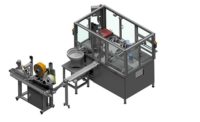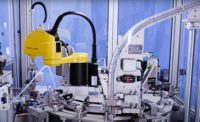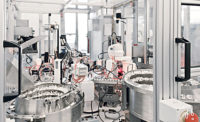Premixed, ready-to-drink, functional beverages are certainly convenient, but that convenience comes with some trade-offs.
Premixed functional beverages require preservatives. Nutrients can degrade during processing, filling, transport and storage. Premixed beverages are typically produced using the “hot-fill” bottling method. The beverage must be heated to 180 F for 30 minutes, then brought back down to room temperature. All that heating and cooling adds cost. In addition, the plastic bottles must have relatively thick walls to take the heat, which also adds cost.
Engineers at Liquid Health Labs Inc. in Manchester, NH, have come up with an alternative—the PowerCap—that avoids these tradeoffs. The PowerCap is a two-piece plastic bottle cap with a cavity that stores liquid or powdered nutrients and flavorings. The consumer screws the PowerCap onto a standard bottle of water. Pushing down on the cap releases the ingredients into the water. After a bit of shaking, the beverage is ready to drink.
The cap comes in different sizes and configurations to fit most standard sizes of bottled water. Besides marketing its own line of beverage mixes, Liquid Health Labs licenses the PowerCap to pharmaceutical companies and other beverage producers.
When the time came to mass-produce the PowerCap, Liquid Health Labs turned to Orientech Inc. of LaChute, QC, to design and build a flexible, high-speed automated assembly system.
Engineers at Orientech designed a 10-station system based on a rotary indexing dial. The system is 10 feet long, 7 feet wide and 6.5 feet tall.
Each station works on four caps at a time with each index, and the system assembles 120 caps per minute, says Robert Genereux, sales representative at Orientech. (The rate might be lower if a liquid will be dispensed into the caps.)
At the first station, a pocket wheel feeds the caps into nests around the perimeter of the dial. The caps are fed upside down to accept the liquid or powder.
The next two stations dispense the ingredients. Station 2 dispenses liquid ingredients with viscosities ranging from water to syrup. Station 3 dispenses powders with textures ranging from flour to sugar. Ingredient quantities are measured by volume. Liquid volume can be changed by simple programming. Powder volume can be adjusted mechanically in 15 minutes at minimal cost.
At station 4, a sensor verifies that liquid or powder has been dispensed into the cap.
At the next station, valves are fed and placed onto the caps. Designed to snap together, the cap and valve are pressed together at station 6.
At station 7, a sensor verifies that the valve is present. Good assemblies are ejected at station 8; bad ones are rejected at station 9.
Station 10 is open. The extra station provides room for an optional unit to apply a foil security seal, which protects the ingredients from outside contaminants.
The system can assemble caps ranging from 28 to 33 millimeters wide. Other sizes can be assembled on the same platform by swapping out tooling.
For more information on automated assembly systems, call Orientech at 450-562-0745 or visit www.orientech.com.
Editor’s note: Whether you’re a systems integrator or the in-house automation team of an OEM, if you’ve designed a system that you’re particularly proud of, tell us about it. Send an e-mail to John Sprovieri, chief editor of ASSEMBLY, at sprovierij@bnpmedia.com, or call 630-262-3293.





